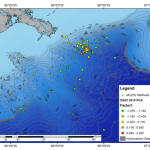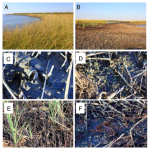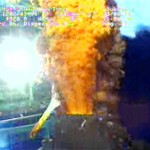I can’t say its the most captivating document ever produced (unless you’ve got a thing for regulatory practices and safety recommendations), but it is an important document nonetheless: yesterday, the newly renamed Bureau of Ocean Energy Management, Regulation and Enforcement (BOEMRE) released its “Final Report Regarding the Causes of the April 20,2010 Macondo Well Blowout.” You can read the full report here.
Nothing in this report is too surprising (and the findings have been relayed over and over by other federal agencies), although this newest document finally gives us a breakdown of why the infamous Blowout Preventer failed. Forensic analysis revealed that:
The Panel concluded that the failure of the BOP [Blowout Preventer] to shear the drill pipe and seal the wellbore was caused by the physical location of the drill pipe near the inside wall of the wellbore, which was outside the blind shear ram [BSR] cutting surface during activation on April 20 or April 22. The elastic buckling of the drill pipe forced the drill pipe to the side of the wellbore and outside of the BSR cutting surface, and was a contributing cause of the BOP failure. The forces generated by the flow from the well and/or forces generated by the weight of the drill pipe led to the elastic buckling of the drill pipe and was a possible contributing cause of the BOP failure.
The panel summary conclusions listed SIX (!!) pages of failures that ultimately led to the Macondo well blowout. The report also found evidence that BP and its contractors were in violation of at least seven federal regulations immediately before the blowout (Captain Obvious had to laugh at the violated regulation requiring “the prevention of the unauthorized release of hydrocarbons into the Gulf of Mexico”).
Company practices which were contributing causes of the Deepwater Horizon disaster included:
- The failure of the crew to stop work on the Deepwater Horizon after encountering multiple hazards and warnings
- BP’s failure to fully assess the risks associated with a number of operational decisions leading up to the blowout
- BP’s cost or time saving decisions without considering contingencies and mitigation
- BP’s failure to ensure all risks associated with operations on the Deepwater Horizon were as low as reasonably practicable
- BP’s failure to have full supervision and accountability over the activities associated with the Deepwater Horizon
- BP’s failure to document, evaluate, approve, and communicate changes associated with Deepwater Horizon personnel and operations
- The failure of BP and Transocean to ensure they had a common, integrated approach to well control was a possible contributing cause of the Macondo blowout.
- The failure of the current Subpart O rule to identify (by definition) personnel who need to be trained in well control operations, specifically in kick detection, was a possible contributing cause of the Macondo blowout.





